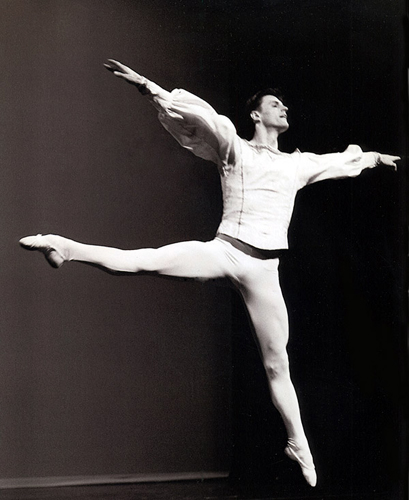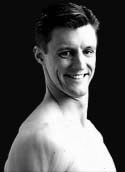Today I’d like to welcome Todd Fox as our latest contributor to 4dancers. Todd originally was going to complete the interview I sent for “10 Questions With…” the feature I typically use to highlight dancers and dance-related professionals on this site.
Time passed and he found himself answering the questions in depth, and after we talked a bit, we decided we would break them down into monthly posts, so that readers could get a closer look at his journey through the dance world. Today is his first post…answering question 1…stay tuned next month for more! -Catherine

1. How did you become involved in dance?
I was born in Miami Florida and from a very early age my mom exposed me to dance. She taught ballet for a magnet arts school in Miami called PAVAC, Performing and Visual Arts Center, and used to drag me around to all the classes she taught.
As I got old enough she made me learn ballet by taking one of her classes each week with her other students. At that age I wasn’t at all interested in studying ballet, I thought it was boring and I hated wearing tights. All I ever wanted to do was go ride my bike with friends or play video games but my mother was insistent, VERY insistent. She eventually presented me with an effective ultimatum, take one ballet class per week or I wouldn’t receive my weekly allowance. So, I studied ballet like this on and off for most of my young life, I went through the motions but never really took a serious interest, it was all just to appease my mom and of course get my allowance.
When I was 13 my family moved to New Jersey and in Somerset County where I attended public school there was a Vocational and Technical School (vo-tech) which had a performing arts program offering dance. There were lots of girls in the Vo-Tech dance program from mine and several neighboring schools with no guys at all. At that age the thought of spending my day dancing around with lots of girls and being the only guy had amazing appeal and much to my mom’s complete jaw dropping shock and surprise I begged for her to let me enroll.
Enrollment in the program meant you spent half a day in regular academic school and the other half studying dance at the vo-tech. In order to enroll you had to attend an audition so with the bit of ballet training I had from my mom I did and was accepted. At that time the vo-tech dance program syllabus was primarily modern dance with the majority of classes centering on Graham and Horton techniques.
Modern dance was completely different from the ballet my mom had taught me and much to my surprise, I really started to enjoy studying dance every-day, especially with all the girls. Only 2 ballet classes a week were given for 1 hour each class with teachers from the resident companies in New Jersey at that time, Princeton Ballet and New Jersey Ballet.
One day in ballet class, a teacher from Princeton Ballet, Karen Russo, taught me how to execute a semi-advanced jump commonly performed by ‘male’ ballet dancers, entrechat six. I could barely do a proper double pirouette back then but Karen showed me a way of breaking down the beats of an entrechat six into two separate movements and after lots of practice I was actually able to do it. Being able to execute an entrechat six was the first time I ever really took notice of balletic movement geared towards ‘male’ dancers. I remember it well because as a young male dancer it gave me an increased sense of identity and as a result I started to become more interested in learning ballet.
Then the bug really bit…. As part of dance education we would watch videos and one afternoon we watched a ballet video (VHS) of Rudolph Nureyev performing the pas de deux from Le Corsaire. Watching that video of Nureyev performing the Le Corsaire pas de deux changed my life, he completely redefined what I thought a male ballet dancer could look like, it was the most incredible thing I had ever seen. From that point on I wanted to be a ballet dancer, I was obsessed with ballet and began accumulating as much video as I could to learn more about male ballet technique.
Nureyev was my idol, I would try to mimic everything about his dancing from what I saw on video; the way he jumped, his movement dynamics, the way he ended variations, his stage presence, his incredible physically, everything. This new found obsession quickly took over every aspect of my life and it got to the point where all I would think about at school was going to take class or watching ballet. Unfortunately, the vo-tech dance program’s ballet class offerings were just not enough to satisfy my ambitions. I desperately wanted to learn more and would always attempt things like double tours, turns in second, or coupe jetes in the back of the studio during modern class which never went over too well with the teachers. It got to the point where the teaching staff at the vo-tech finally suggested to my parents that if I really wanted to get serious about training to become a male ballet dancer I should audition for the School of American Ballet (SAB) just across the river in New York City.
At the end of that year I auditioned for the year round training program at SAB, was accepted on scholarship and that was where my true formal training as a male ballet dancer began…

Throughout his professional career Contributor Todd Fox has performed with ballet companies around the world including Ireland’s Cork City Ballet, South Africa’s Ballet Theatre Afrikan, Yugoslavia’s Serbian National Theatre Ballet, Scotland’s Ballet West, Venezuela’s Ballet Metropolitano de Caracas, Ballet Concierto de Puerto Rico, Isle of Man’s Manx Ballet, and the USA’s Cleveland San Jose Ballet, BalletNY, and Joffrey II Dancers.
Described by the New York Times’ Jack Anderson as, “most notable for his effortless jumps”, Mr. Fox’s performance repertoire includes such favorites as Albrecht in Lavrovsky’s Giselle, the Angel in Rudolph Van Dantzig’s Four Last Songs, Pas de Cinq in Rudolph Nureyev’s Sleeping Beauty, The Fool in Agnes de Mille’s Three Virgins and a Devil, Stanton Welch’s Orange, George Balanchine’s Apollo, Valse Fantaisie, and Tchaikovsky Pas de Deux, Escamillo in Roland Petit’s Carmen, Gerald Arpino’s Kettentanz, and Antony Tudor’s Continuo.
Theatrical credits include the Off-Broadway production of Life’s Too Short to Cry, National Tours of Dreamgirls, Cinderella starring Phyllis Diller, the Teenage Mutant Ninja Turtles Out of Their Shells Tour!, and most recently Todd originated the role of Police Chief Louis Renault in Warner Brothers Theatre Ventures’ original production of John Clifford’s Casablanca The Dance. Television appearances include performances on Live with Regis and Kathie Lee, the RTÉ broadcast network reality series Ballet Chancers, The Drew Carey Show, and in the Emmy nominated broadcast of Blue Suede Shoes.
Since 1998 Todd has worked as an agent/manager specializing in the representation of high profile guest artist ballet dancers from around the world. He has successfully negotiated contracts for many clients governing a wide array of live performance engagements and film.





I’m dying to know, how exactly did your teacher break down a entrachat six into two basic movements? I would love to be able to have a new way of explaining a six to my students!
OK so I have to be honest, that was like 20 years ago when Karen taught me how to do ‘Entrechat six’ but I will do my best to recall the exact process. Please understand that my description below is as I remember it and she (Karen) may or may not still teach it this way.
The two movement jump formula was basically this: “entrechat quatre on the way up and changement on the way down” practiced in that order.
First I learned how to do an ‘entrechat quatre’ and practiced executing it over and over again until it became more natural. Then, I had to practice executing entrechat quatre with an emphasis on finishing the beat at the height/peak of the jump. I remember using two barres parallel to each other so I could help push-off with my arms for extra height to practice this upwards beat emphasis. Isolating the primary entrechat quatre movement into the ‘upwards’ portion of the jump allows for the remaining beats ‘changement’ to be executed on the downwards. Once I built up enough strength in my legs to achieve this entrechat quatre emphasis the changement was then added. At first it was a bit overwhelming to get all the beats in but using the studio barres to push off of helped quite a bit. Eventually my leg strenght increased to where I could get all the beats in without pushing off the barres and voila, the beginning examples of a step I have since executed thousands of times throughout my career.
It is important to note that I was actively taking ballet class and doing additional exercises to build up inner thigh strength during this process. Entrechat six is not an easy movement to execute so if you are reading this and suddenly want to try, please be sure you are actively taking ballet classes and consult your instructor.
FYI, Karen Russo is presently Artistic Director of Dayton Ballet, you can read more about her here http://www.daytonballet.org/staff.php
Thanks for the response! Crazily, that is exactly how I teach entrachat six! Quatre on the way up and the last beat on the way down. I also always found it really helpful, personally, to count the beats out in my head evenly so that you don’t rush them, and end up with flailing legs. Counts (and leg beats) one and two are going up, and three is the landing.
I have my students practice the coordination at the barre without jumping. They start in fifth and then swing one leg from fifth front to a flex-footed first (a millimeter or so off the ground) to fifth back, all with a with flexed foot, so they can get the idea of how much thigh work has to happen to make for clean battu. I like your idea of using the two barres though, and might well use it in a future class.